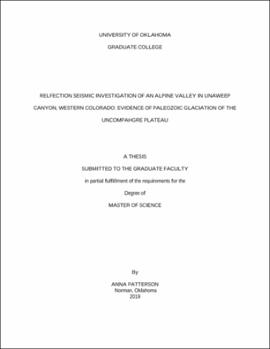| dc.contributor.advisor | Michael, Behm | |
| dc.contributor.author | Patterson, Anna | |
| dc.date.accessioned | 2019-05-09T15:54:41Z | |
| dc.date.available | 2019-05-09T15:54:41Z | |
| dc.date.issued | 2019-05 | |
| dc.identifier.uri | https://hdl.handle.net/11244/319653 | |
| dc.description.abstract | Unaweep Canyon in Western Colorado is a unique landscape which has a puzzling history. The canyon has a wide U-shaped profile in the west that contrasts with the narrow V-shaped river carved canyons nearby. Many suggest that the canyon was carved by the ancestral Gunnison River and then later abandoned, but this hypothesis does not support all the canyon’s geomorphologic features. Others have suggested that due to the canyon’s unique U-shaped profile and other glacial geomorphologic features, that the canyon was carved initially by a late Paleozoic glaciation and later exhumed by the ancestral Gunnison River. This hypothesis is highly contested since this region of western Colorado was equatorial during the late Paleozoic, and climate models do not support equatorial glaciation in the late Paleozoic. Previous work including shallow seismic, drilling and a gravity survey determined that there is a thick sediment fill hiding the Precambrian basement geometry. Understanding the geometry is critical in determining how the canyon formed. Further seismic work was needed to delineate the basement geometry.
Active reflection seismic was used to obtain a high resolution and clear image of the Precambrian basement to aid in the investigation of the genesis of the canyon. A 2.45 km seismic line was acquired across the broadest part of Unaweep Canyon. First arrival tomography was used to create a smooth velocity model of the shallow subsurface. The lack of fast velocities imaged in the southern segment of the tomographic model suggest over-deepening of the Precambrian basement. The results from the reflection seismic confirm an over deepening of the Precambrian basement with a precise U-shaped geometry, and a basement depth of ~450 m in the over-deepened portion. Due to lack of significant faulting seen in the survey and lack of glaciation during the Quaternary, the structure is interpreted to be an alpine glacial valley supporting the hypothesis of glaciation during an earlier interval of Earth history—most likely the late Paleozoic. This evidence is in contrast with current climate models of the late Paleozoic which fail to depict glaciation in equatorial uplands. | en_US |
| dc.language | en_US | en_US |
| dc.subject | Unaweep Canyon | en_US |
| dc.subject | alpine valley reflection seismic | en_US |
| dc.subject | glaciation of the Uncompahgre Plateau | en_US |
| dc.title | RELFECTION SEISMIC INVESTIGATION OF AN ALPINE VALLEY IN UNAWEEP CANYON, WESTERN COLORADO: EVIDENCE OF PALEOZOIC GLACIATION OF THE UNCOMPAHGRE PLATEAU | en_US |
| dc.contributor.committeeMember | Soreghan, Gerilyn | |
| dc.contributor.committeeMember | Bedle, Heather | |
| dc.date.manuscript | 2019-05-08 | |
| dc.thesis.degree | Master of Science | en_US |
| ou.group | Mewbourne College of Earth and Energy::Conoco Phillips School of Geology and Geophysics | en_US |
